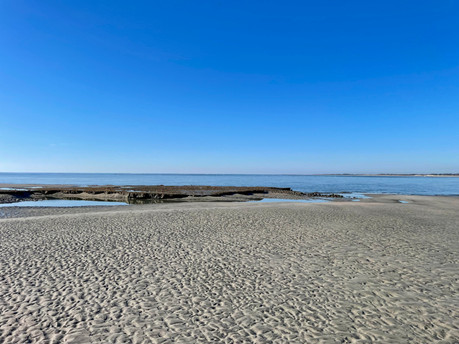A Gorgeous Day Birding Folly Beach County Park, eBird Hotspot # 23
- birding211
- Mar 26, 2023
- 3 min read
As I continue to bird the top 50 eBird hotspots in Charleston, I recently visited Folly Beach County Park ranked #23 on eBird's Hotspot list with 207 species of birds recorded.

I set out on a cool, clear and sunny morning. It has been a while since I have visited this location so I was excited for the day ahead. I had reviewed a few recent eBird reports showing that Red Knots have arrived on the Charleston coastline. These amazing sandpipers visit Charleston each migration to refuel for their incredible journey.

The first bird of the day was a House Wren calling in the scrub along the parking lot. I moved closer to the chattering Wren and found several other birds including a Song Sparrow, Swamp Sparrow, and Red-winged Blackbird. Listen below to the House Wren call with a Red-winged Blackbird and Song Sparrow in the background.
I walked along the sandy pathway through the dunes toward the beach. It was a beautiful sight, clear blue skies over tranquil blue waters. Gulls and terns were patrolling the calm shoreline. I noticed a rocky jetty still above the incoming tide and it was covered with Sanderlings and Ruddy Turnstones. It was an entertaining sight watching the birds foraging in-between oncoming waves and rising water.

Sanderlings, Ruddy Turnstones Video:

As I walked the beach toward the Folly River I approached a Ring-billed Gull enjoying some fresh Cannonball Jellyfish. Scattered Sanderlings were running along the edge of the run up water from the ocean waves.


Further down the beach I could see 3 Black Scoters diving just offshore.


As I made my way down the beach there was a large area of mud exposed from the tidal water. I watched a Black-bellied Plover looking for meal in the mud. A Willet was also looking for some good eats in a deeper pool of water.

Willet Video:
Also along the edge of the mud flat and oyster beds there was a mixed flock of small sandpipers. This mixed flock were mostly Dunlin showing their longer decurved bill. They were accompanied by several Least Sandpipers, our smallest sandpiper with yellowish legs, and there were a few Western Sandpipers too.
Dunlin Video:
Western Sandpiper (left), Least Sandpiper (right) Video:
I walked a bit further around the bend to explore some more exposed mud flats and oysters, I found several Boat-tailed Grackles, more Dunlin and a Black-bellied Plover.


I returned to the mouth of the Folly River and set up my spotting scope to view the resting birds on several distant sandbars. The sand bars were populated with groups of Brown Pelicans, Forster’s Tern, Royal Terns, Laughing Gulls, Ring-billed Gulls, Herring Gulls, Dunlin and Red Knots! I counted over 60 Red Knots foraging on the sandbar in the distance.

Red Knots are a medium sized Sandpipers that stop in South Carolina twice a year during spring and fall migration. Some Red Knots will travel over 9,000 miles twice a year from their wintering grounds in South America to their breeding grounds in the Arctic. Unfortunately, Red Knot populations have declined a devastating 87% since 2000. Charleston County hosts more than 40% of the population during migration. To learn more about these amazing birds I have added a few web-links at the end of the blog.

I counted the birds I could see through the spotting scope and tallied my eBird list. As I was enjoying the long views across the water a couple of Forster’s Terns began calling and patrolling the water nearest to me.
Out of nowhere a Northern Harrier flew right over me and headed toward the salt marsh, I quickly snapped a few shots as the raptor flew out of sight.


I headed back down the shoreline passing the same 3 Scoters from earlier. I noticed a large bird sitting on the water in the distance so I decided to take a closer look through the scope. The large bird turned out to be a Northern Gannet resting on the calm ocean. I also noticed a few larger groups of Black Scoters off in the distance.



It was a beautiful walk on a gorgeous March day in Charleston. I observed 37 species of birds with a highlight of 62 Red Knots! I covered 1.54 miles in 1 hour and 31 minutes. eBird checklist: https://ebird.org/checklist/S131865446
Happy Birding!
-Charles
Red Knot information web-links:
.png)
















































































































































Comments